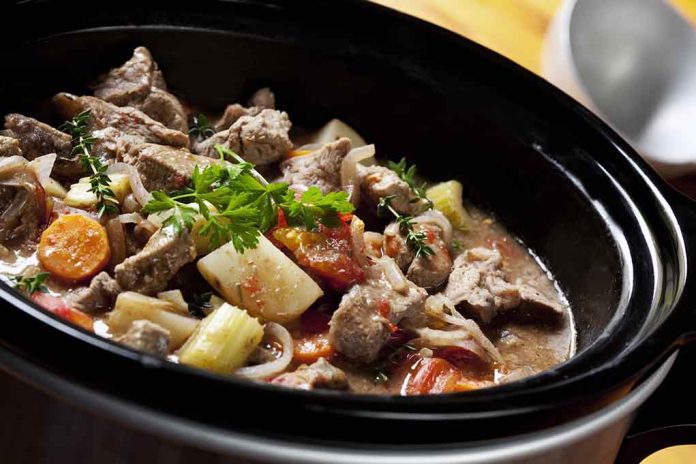Warm up this winter with some slow-cooked comfort food! Using a slow cooker or the slow-cook function of your electric pressure cooker is an easy way to make your favorite seasonal meals. After you prep the ingredients, you can put them in the cooker, start it, and forget it. After a few hours, you have a warm, flavorful meal ready to enjoy. Safely prepare slow-cooked food by following these steps:
- If you plan to use frozen meat, poultry (such as chicken or turkey), or seafood in the dish, give yourself enough time to thaw it safely before adding to the slow cooker. Do not thaw frozen food on the counter. Instead thaw it in the refrigerator, in cold water, or in the microwave. Begin to cook your meal immediately after thawing the meat if you thawed it in cold water or the microwave.
- Wash your hands for 20 seconds with soap and water before preparing your slow-cooked meal.
- Rinse fresh fruits or vegetables in your recipe under running water before cutting or peeling them.
- When cutting up ingredients for your meal, keep raw meat, poultry, and seafood separate from any food you plan to eat raw (for example, garnish or toppings like cheese, cilantro, or lemon zest). Use separate cutting boards, plates, and utensils.
- Large cuts of meat and poultry may be cooked safely in a slow cooker. However, since slow cookers are available in several sizes, check the instruction booklet for suggested sizes of meat and poultry to cook in your slow cooker.
- After touching raw meat, poultry, or seafood, wash your hands again for 20 seconds with soap and water.
- Vegetables cook slower than meat and poultry in a slow cooker, so put the vegetables in first, for the best quality.
- Add meat, poultry, or seafood to the slow cooker. Make sure your slow cooker is between half and two-thirds full. If it’s too full, the food may be undercooked and unsafe. If it’s not full enough, the food may be overcooked.
- Start your cooker right after you finish prepping. Do not set a timer to start cooking later in the day. Bacteria can multiply quickly in the parts of the food that reach room temperature before cooking begins.
- While your meal is cooking, wash your utensils, cutting boards, and countertops with hot, soapy water, or put them in the dishwasher if they are dishwasher safe.
- Cook your meal to the right temperature to kill germs. You may assume that your meal is safe to eat because it has slowly cooked for hours, but the only way to know for sure is to use a food thermometer. Place the food thermometer in the thickest part of the food, avoiding bone, fat, or gristle. Check to see if it has reached a safe internal temperature:
- Whole cuts of beef, pork, veal, and lamb: 145°F (then allow the meat to rest for 3 minutes before carving or eating)
- Fish with fins: 145°F or cook until flesh is opaque
- Ground meats, such as beef and pork: 160°F
- Egg dishes: 160°F
- All poultry, including ground chicken and turkey: 165°F
- Wash your hands again for 20 seconds with soap and water and enjoy your warm meal.
- Refrigerate your leftovers within 2 hours of cooking (1 hour if exposed to temperatures above 90°F, like in a hot car). If you leave leftovers out too long, bacteria can multiply rapidly and make you sick.
- Wash your cooker insert and lid with hot, soapy water, or put them in the dishwasher if they are dishwasher safe.
Read the full article here.
As published on HealthyExaminer.com














